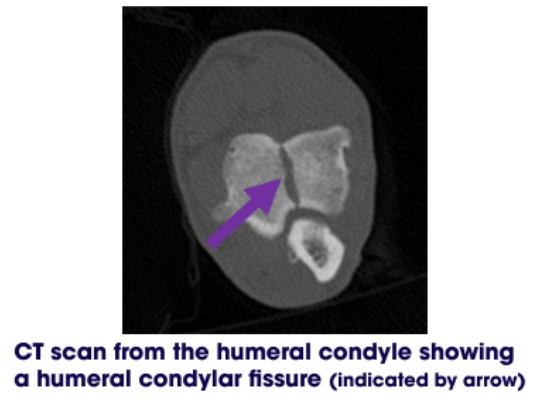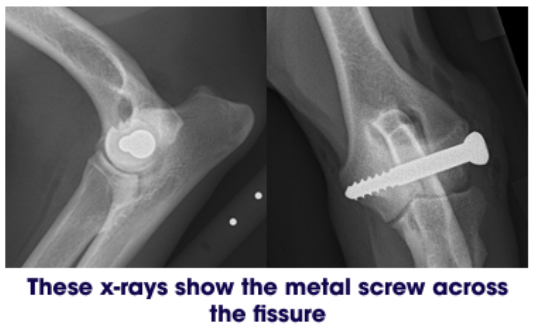What is a humeral intracondylar fissure?
The humeral condyle, along with the radius and ulna make up the elbow joint. In some dogs a fissure, or crack, forms across the humeral condyle. This is known as a humeral intracondylar fissure (HIF). It is also sometimes called ‘incomplete ossification of the humeral condyle’ (IOHC). HIF can cause pain and lameness and predisposes the bone to fracture. These fractures can occur during normal exercise and can be very complex fractures involving the joint.
HIF occurs most commonly in spaniels, but we have seen other breeds affected. Any age of dog can be affected.
How are Humeral Intracondylar Fissures treated?
In most cases where dogs present with lameness and pain localising to the elbow, and HIF is confirmed, surgery is recommended to reduce pain and minimise the risk of future humeral condyle fracturing. The operation involves placing a large metal screw across the fissure through a minimally invasive approach.
What are the potential complications?
As with any surgical procedure complications can occur including seroma formation (the accumulation of fluid under the skin at the surgical site) and infection. Due the nature of the condition, in the long term, the fissures rarely heal completely. The screw therefore supports the humeral condyle for the rest of the dogs life. The screw is therefore subject to stress in some patients which can result in the screw breaking. If this occurs the screw may need to be replaced.
What is the outcome following surgery?
We expect more than 90% of dogs to make a full and rapid recovery following surgery and regain normal quality of life. Where complications occur further surgical interventions may be required.
What is the aftercare following surgery?
Your pet will be discharged with painkillers and in some cases may also receive antibiotics. Most dogs begin to use their operated limb on the day following surgery and are walking well within a couple of weeks.
Exercise restriction:
Your dog should be cage or pen rested for two weeks and should be walked on a short lead for a maximum of five minutes, three times daily for toileting only. Patients should be walked slowly and encourage to use the operated leg. Your dog must not be allowed to run around the house, play, jump onto or off furniture, climb stairs or fall on slippery floors during this period.
Please contact your vet or Langford Vets if you are concerned that limb use is not improving or suddenly gets worse as an appointment for examination and further x-rays may be required.
After the skin sutures have been removed room rest can be allowed (unless instructed otherwise on the discharge instructions). A gradually increasing amount of on the lead exercise will then be introduced.
Wound care: The skin incision should be checked twice daily for two weeks following surgery or until the skin sutures have been removed. Licking or chewing of the surgical site can cause infection, and so we recommend that a buster collar is worn until the skin sutures are removed. If discharge or increased swelling is noted you should contact us and an examination may be necessary.
Follow up appointments
Unless advised otherwise, a revisit appointment with langford Vets will be recommended in six to eight weeks for a check-up and postoperative x-rays to assess bone healing. Please note there will be additional charges for this appointment.


